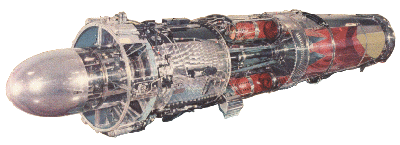With some excitement I read about NASA preparing to test the modified X-43 last week (the original was to be tested back in 2001, but dumped into the ocean before firing the engine due to bad handling of the control surfaces during rocket boost). Well, it launched and flew wonderfully which is great. The researchers now have data which is going to keep them busy for years, and hopefully we'll see additional tests, and maybe even a manned version.
 |
 |
| takeoff of test craft attached to a B52 | booster rocket firing to lift the test craft to 98,000 feet |
Why is the X-43 so exciting? Its not a space ship or anything. Its a hypersonic jet, with the first successfully fired SCRAMJET (outside of a wind tunnel). Ok, what's a SCRAMJET? Come on, I knew what a SCRAMJET was back when I was 12 (and that was quite a while ago). I could even draw the design of one. Its a supersonic version of a RAMJET. Which is what? Ok, ok, lets start at the beginning.
Back in the 1930s the first jet engines were created separately by both Frank Whittle and Hans von Ohain. However, it was only as war was breaking out in Europe that they were built. Unlike a conventional airplane, which uses a regular internal combustion engine to turn a propeller; the jet combined the source of energy directly with the end result: a fan first compressed the air which was then combined with fuel and ignited, which all blew out the back end, turning a compressor and then shooting out the exhaust port. While propeller driven planes work great at slow speeds, jets are much more efficient when trying to go fast (especially when trying to go faster than the speed of sound). Unfortunately, it is a somewhat complicated machine.

In addition to the design with the compressor (or fans for multiple stage versions) and turbine, others worked at simplifying the mechanics involved. This led to other designs, such as the pulse jet and the ramjet. The ramjet worked by compressing the air stream, then expanding it into a combustion chamber, then letting the exhaust flow out the rear. This engine has no moving parts, but requires that the air be flowing in (and thus the jet be moving) at a quite high speeds before it will actually fire and produce thrust.
A modified form of the ramjet is actually very common on military jets: the afterburner. There gasses are already moving very fast coming out of the first stage engine, and when mixed with additional fuel, can produce additional thrust: providing extra power for take-off, acceleration, and top speeds well beyond the speed of sound.
Unfortunately, both the conventional jet and the ramjet suffered from one critical design problem in the quest for high speeds. They both had to slow the airflow down to sub-sonic rates in the combustion chamber. Now that didn't prevent the plane from going supersonic, but there are limits to the expansion and compression ratios you can put the airflow through and still get decent results. The fastest jets today go between MACH 2 and MACH 3, and the fastest test RAMJET missile went MACH 5.4.
The scramjet is designed to go hypersonic (really fast) and even the combustion chamber works with supersonic gas flows. Everything is designed for the shockwaves and other weirdness' that happen at that speed. Of course this engine is even worse than the RAMJET for its starting speed requirements. Something else has to get you going several times the speed of sound just to get it started. But then it will kick in and really push you out there. The X-43A test target was MACH 7, which it hit without a hitch. With hydrogen fuel (which is what the test craft used), these engines should be able to go beyond MACH 20 (which is 14,823 MPH or 21,750 feet per second).

Only forty years and $250 million to get this far. Of course people were talking about space planes using this engine thirty years ago like it was just around the corner. It was even used as the basis for a 1983 space based retread of the old Airport disaster genre, Starflight One, which starred Lee Majors and Lauren Hutton.

I guess forty years is actually pretty fast for this kind of development. Its also pretty exciting for NASA, combined with its Mars images and press about proposed moon and manned Mars missions. NASA is not the boring--nothing happening here--agency it used to be. Still I think its still going to be quite a while before we something like this:

[links]
Press release on the X-43A flight from Dryden Flight Research Center,
Nasa X43 Mission Page
A history of the jet engine, Wikipedia: jet engines
Aviation History's basic theory of a modern jet engine as part of its general aircraft engine theory.
A history of engine research from the McCook Field Airforce Research Labratory
An introduction to the tradeoffs of RAMJETs, SCRAMJETs, and pulse jet engines from a french conference (mostly english).
The X-15 RAMJET powered NASA test aircraft.
